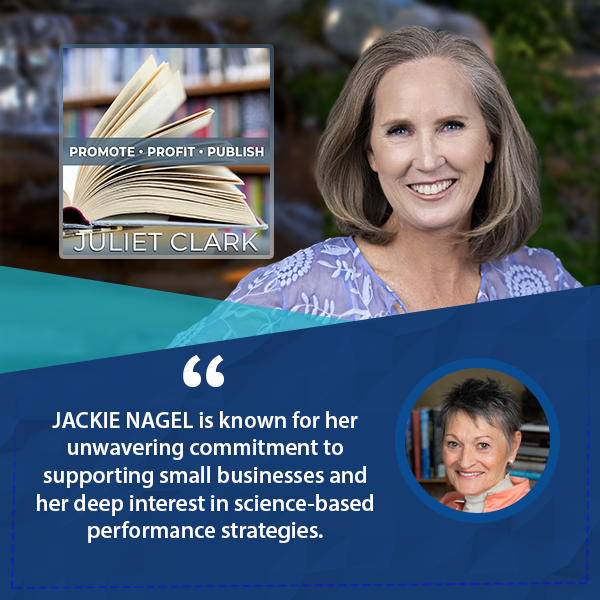
Your business deserves to grow, and you deserve to break through the challenges that are holding back your business. You should learn the secrets of this episode’s guest. Jackie Nagel, the Founder of Synnovatia, a strategic business coaching and consultancy firm, shares her game-changing insights to bring prosperity and grow your business. She unravels the stages of business growth, its hidden killers, and her roadmap to bridge the gap between planning and action. You’ll also learn the power of leverage in achieving explosive growth. Traverse into the depths of your business with the guidance of an expert. Join Jackie Nagel today so you won’t miss her wisdom.
For more information about Jackie Nagel and the services offered by Synnovatia, you can visit their website at www.synnovatia.com.
—
Watch the episode here
Listen to the episode here
Bye-Bye Plateau, Hello Prosperity: Jackie Nagel’s Game-Changing Insights
I’m excited about my guest because she was my mastermind facilitator, and she’s a bomb business coach. You guys are going to enjoy her because of what’s going on with the economy. Everybody needs to be changing a little bit. It’s harder to do things than it was in the past. I want to remind you that we have the AI class, AI for Authors, coming up again in June 2024. The people who were in it were completely blown away.
We created courses, quizzes, and keywords. We created all sorts of stuff in minutes right on the calls when people did their one-on-ones. They brought their problems, and we sent a lot of people away happy. I’m excited about that. If you want to sign up for it, it’s AIAuthorAcademy.com. We will be starting again at the beginning of June 2024. It’ll be June 4th, 11th, 18th, 25th, 2024. On the 25th, for the group sessions. You get a one-on-one every week. You can bring your own staff. We completely work on whatever you need or have problems with. Don’t forget to go over to get your copy of Breakthrough Author Magazine, www.BreakthroughAuthorMagazine.com.
Our guest is one of our contributors here. Jackie Nagel is the Founder of Synnovatia, a strategic business coaching and consultancy firm. She’s known for her unwavering commitment to supporting small businesses and her deep interest in science-based performance strategies. Jackie’s approach includes providing personalized strategic coaching tailored to the individual needs of her clients, both on a personal and professional level. Her clients greatly appreciate her keen insights into what it takes to succeed in a constantly changing and increasingly demanding business environment. For more information about Jackie and her services, you can visit her at Synnovatia.com.
This is what impressed me the most about Jackie’s group. I’ve never been part of a mastermind before where they brought in economists. Everybody in the group was worried about where the economy was going. What better advice from actual economists instead of me digging through those job reports by myself and not liking what I see? Jackie, welcome.

I’m excited to be here. Thank you for that generous introduction. Do you know, when Juliet introduces you, you go, “Who is she talking to?” I want you to follow me around all day long, but I’m excited. I’m grateful that you’re here on an early Friday morning and taking time out of your busy schedule to talk about some of the things that might be going on in your business. If you feel that your growth may have stalled or slowed, you’re at the right place. We’re going to talk about some of the little unknown causes of a business plateau and what you can do to break through to the next level.
The information that I want to share with you comes from many years of working with small business owners. I have the privilege of being in a front-row seat for all these businesses. We’ve seen everything, the good, the bad, and the ugly, but more importantly, what I’ve seen is patterns that emerge that show why business starts to slow, what causes the sticking point, and what is most effective for breaking through some of that information or plateaus. That’s important when we begin to think about small businesses because oftentimes, the information that we see online or read in a book is designed for a corporation. It’s not applicable to what our situation is.
We’re moving on, apparently, but because of the signs of our group, speak up, ask a question, raise your hand, and jump in. That works well for me. We can have a good conversation about it. We’re going to be talking about the stages of business growth and some of the common sticking points that cause a business to stall. I’ll outline some of the solutions that my clients and I have found in working with some of the challenges that come up.
The Stages Of Business Growth
These are the five primary stages of business growth. You see the startup on the left, which is generally relatively smooth. You get to the core business development, which is stage two. You go into the messy middle. That’s when things get interesting. That’s generally the area where I work now with most of my clients. From the messy middle, we move into expansion and professionally manage until your organization exits.
What I would like to do is focus mostly on the startup, the core business development, and the messy middle because I would assume that that’s where the majority of you are in your business. The startup, we’ve all been there. You’re all established businesses, but I’m sure if you reflect back, you remember the startup and how exciting it was. Slay the dragons. That’s what I remember about being a startup. I thought anything and everything was possible. It has all the excitement of a new baby when it’s your first. After that, we know what happens in baby two, but at stage one, this is where we work at proving our business model.
Our primary focus is on marketing. It’s proving your business model and primarily focused on marketing and getting your marketing dialed in, getting your sales funnel set up, and getting everything rolling. Although it’s an exciting time, it’s not without its growth pains. I’m sure you remember that we’re excited. Sometimes, we’re not realistic in terms of expectations that we have of the market and ourselves. That self-esteem takes a hit.
I work primarily in the professional service sector. Most of my clients are accountants who want to start a business. They are the attorney who’s in business. They are the ad specialists who are in business or web design. They’re masters of their craft. The idea of even knowing about business and understanding that there needs to be some planning process in place is generally missing. Planning becomes ad hoc.
The biggest thing that I find is that, at least for me and my clients, this may not be for you, but there’s this incredible desire to be everything to everybody. Subsequently, we end up taking on clients who aren’t a good fit for us. We underearn. We’re underpricing. Cashflow takes a hit, which makes it difficult to grow.
The good news is we’ve got a lot of grit. That causes us to move into stage two. This particular stage is about developing your capacity and your systems. However, most business owners in stage two may not realize that. It’s something that systems get overloaded quickly in this stage. Because of that, you start growing your network, acquiring clients, dialing in your pricing, and developing your reputation.
Systems get overloaded quickly. Sometimes, you start bringing in talent at this point. Most people get overwhelmed. Talent is not on their mind because of some cashflow issue, which brings us to stage three, the messy middle. This is where the wheels come off the bus. It’s chaotic and overwhelming. Cash gets tighter, and finding the right talent becomes a challenge.
The good news about this stage is that the experimentation has paid off for most of the people within this stage of business. This has more to do with revenue than it does with time in business. I’ve worked with people who have been in business for several years and are not yet at this stage, but to get to this stage, you’ve proven your business model, and you’ve got your target audience styled in.
These are some of the common sticking points that we run into. Usually, when you hit these levels of revenue, $150,000 to $200,000, is stage two of core business development, where growth may start to slow. $350,000 to $500,000 is in the messy middle, where growth starts to slow because of the many challenges that come with the systems getting overloaded. You’d think it would stop there, but unfortunately, we usually see another sticking point somewhere between $750,000 to $1 million and $3 million to $4 million.
That might give you some hope if you’re in that revenue, and you’re like, “This is expected. It is common. The other thing that we find is that there are some commonalities for all business owners. It doesn’t matter whether you’re at $150,000 or $3 million and stuck because, as a business owner, this is what you’re going to start to experience if you haven’t already.
Major burnout starts to kick in. You are working 50, 60, 70 hours a week. My dad would say, “You’ve come to the end of your sleeve. You are way beyond.” Although you might worry less about survival because there is some cashflow, you’re still overwhelmed. The days are chaotic. You go from fire to fire, and you only wake up and do it all again the next day. Unfortunately, this way of working is unsustainable. It needs to be unsustainable. I’ve been there. My clients have been there. You have all been there.
This is with, at stage 2, where you start to say, “I wonder if Safeway is hiring donut hole friars. I wonder if Starbucks needs some baristas.” It’s about anything is better at this point. If you’re thinking about having those thoughts, don’t feel bad as a business owner. We’ve all been there. This is also where the business owner themself begins to bottleneck their own growth because of the overwhelm. There’s little to no time.
This brings us to what got you here won’t get you there. What we’ve discovered is that the skills, the knowledge, the ability, and the beliefs that you have that got you to the level that you’re adding your business are no longer applicable to take you to the next level. Think about your computer. I’ve been around longer than the rest of you. Think about running Windows 95 or DOS 1.0 on your computer and how slow things would be. We always upgrade our computers. We need to do the same thing to a lot of our systems and skillsets to get to that next level. Any questions so far? Any experiences you want to share that you go, “I thought of being a gardener except on the days it rains.”
Bye-Bye Plateau, Hello Prosperity: Jackie Nagel’s Game-Changing Insights Share on X
We need to upgrade most of our systems and skill sets to grow.
I had an experience. We were about to launch. My business partner sent me a breakup text and said, I’m not going to do this anymore.” She quit. She’s the one who handles all the systems. I was like, “What do I do now?” That was fun.
Were there any red flags, warning signs, or anything that had happened before?
At the time, yeah. It’s okay. It made me regroup and refocus.
That’s always fun.
I had one too. A long time ago, I gave up. I went and got a job in accounting. It was funny because it was out of a woman’s home. It was supposed to be a three-month job. I finished all the work in one week. It was in her house. I went to the bathroom. I saw the garbage can full of Snickers wrappers. I came out and said, “Somebody had a good time last night.” She left me a note on the door the next day, firing me and telling me to mind my own business. I was efficient because I owned my own business and finished all the work right away.
When you’ve been in business for a while, that’s where pricing is huge because you can do things much more quickly. You end up making less money if you don’t increase your rates to coincide with your skillset. We’ve all been in business long enough to know we can do things like this. We see things because we’ve honed our skills. Our pricing should reflect that, which is about strategy.
I want to share with you the six areas that we have seen that contribute to a sticking point. They don’t all happen all at once. This is not in any sequence, but these are the big rocks to take a look at. I want to cover each one of those and give you some suggestions. I don’t recommend you do it all, but whatever bubbles are at the top for you, use your intuition. You got women on this call, which is lovely. Use your intuition and leverage that to determine where to start.
The first area is our own mindset and skillset. When business starts to go sideways, what I have found many times is the entrepreneur starts to double down. They’re like, “I’m not working hard enough. I’m not working smart enough.” They drill down and work harder in a lot of different ways, although that’s an option. It’s unsustainable. It won’t move the dial in the long-term aspect of the business.
Some of the other recommendations that I have is to challenge yourself to hang out with business owners who are at that next level. They think, talk, and focus on different things. It’s different air that they breathe. It is a good challenge to hang out with those people. I have to tell you a quick story. Before I started Synnovatia, I was in sales. I went to this one conference. There was a woman there who had a thick Texan draw. She talked about the people we hang out with and how some of the people that we hang out with.

Grow Your Business: Challenge yourself to hang out with business owners who are at that next level. Because they think, talk, and focus on different things.
She challenged us to make a list of the people that we hang out with and put a positive sign next to the people that we feel better about ourselves when we are with them and the minus signs when we feel worse about ourselves when we hang out with them and the equal sides. She said at the end, “What in the sale are you doing hanging out with the minuses and the equals?” That has always stuck with me because that is pertinent to us as business owners.
Mastermind Group
Juliet referred to the mastermind group. Find a mastermind group that is a stage above you. In the mastermind group that I run, everybody is at the same level or within this sphere. It works out well. Because of the conversations and what people are experiencing, they’re having common challenges. Challenge yourself to read more non-traditional business books to challenge the status quo.
I don’t know if this is pertinent to you, but I know that for myself and some of my clients, we look to the “experts” in the industry to guide us and from whom we get our information. What I find is that they’re speaking to corporations. There’s little that pertains to us that is applicable. We tried to apply it, but it didn’t work.
The other thing is there are some best practices that are touted in the industry that don’t work. They may have worked in the ‘90s or even in early 2000, but where we’re at today in the last several years in business is completely different. The rules of the game have changed. Watch the year that the book was published. That’s what I always say because that will give you some real insight.
The other thing that can help rebuild your mindset is to learn everything that you can about strategy because that is going to take you where you want to go. It’s lovely to learn about bookkeeping. I remember my early days learning everything I could about marketing. I look at that and think, “I wish I would’ve had somebody to tell me not to do that. Don’t spend your time doing that.” Hire people who are more qualified and can get the job done much more quickly. Your job as the CEO of your company as you grow is to provide oversight to do strategy and to make sure that that strategy gets executed. Learn what you can about strategy. Any questions about mindset or skillset?
The next one is talent. Doesn’t that look like your staff or subcontractors if you don’t have staff? The one thing that we found is that many times, if you’re stage two or stage three, you may have brought on some talent where there are subcontractors or staff members, and unfortunately, some stagnation occurs within the talent pool because it has to do a lot with our own lack of experience. We have a tendency. It may be cash flow and worry about sustainability. We have a tendency to hire inexpensive talent, which is people who are unqualified or not qualified. They may be qualified, but they don’t grow with a company.
What happens is we’re used to being the lone ranger and doing everything ourselves. It becomes difficult to delegate to other people and trust that they’re going to do the job there. It’s scary when you think about delegating, turning everything over, and crossing your fingers and hoping to God they do it the way that you would want to have them do it. However, there is a way to delegate. There’s a process that you can go through to delegate to make sure that things get done the way that you would want to have them done and that your talent is properly utilized.
The other thing is a couple of other recommendations when we get to the talent part because there’s a capacity issue. There’s only so much that you yourself can do. Until you bring on additional capacity in the area of talent, it’s going to be hard to move to that next level, regardless of how much you optimize or automate the system.
When you’re hiring talent, consider hiring talent that’s going to move the needle with revenue because they begin to pay for themselves. It’s common to want to hire a virtual assistant or an executive assistant to take the mundane tasks off our plate. The administrative assistant ends up being more on the liability side of the balance sheet rather than the asset side. They become more of a cost rather than a benefit unless you, as the owner, take a look at how many hours I am being freed up and what I plan to do with those hours to generate revenue. That’s the only way that that works.
The other recommendation that I would have for you is to don’t pitch pennies on talent. It’s hard when cash is tight or when you are concerned about what cash is going to look like next quarter. I’ve got story after story of people who have brought in inexpensive talent, trying to look for the best we can get for what we think we can afford. It ended up costing them more money in the long run. The other thing that I suggest is not to bring people in to train them. She or he is not qualified, but I can train them. That doesn’t pencil in when you start looking at your time, their time, and the opportunity costs because you’re away from revenue-generating activities that are costly.
Bye-Bye Plateau, Hello Prosperity: Jackie Nagel’s Game-Changing Insights Share on X
In order to manage the cash issue and your concerns and get good talent, we found a couple of things that worked well. Consider a hybrid. Bring somebody on as a subcontractor for a couple of months so they can prove their ability and ensure that they’re a good fit before you bring them on, and you can decide. Is this something I want to do, commit to, and bring him on as an employee? Give them a test project before you even bring them on as a subcontractor. That’s worked extremely well.
Have any of you had a situation where somebody interviewed well, you brought him on, and it didn’t take you long before you realized that they oversold their abilities and skills? Yes, that’s happened to me. I interviewed somebody several times. My HR consultant interviewed somebody, and I figured, “If I miss it, she’s going to pick it up.” The woman came to work. It was like, “What is this all about?” Her skillset for where she was working was fabulous, but what I needed was much higher, and she was not equipped for that.
Had I known about doing test projects back then? I could have given her a project to do that was at the level that I needed for her to perform on day one, paid her for the project, and I would’ve been able to ascertain after that one project whether or not she was a good fit. Those are a couple of things that we’ve done with some of our clients that have worked extremely well in helping them move to the next level.
The next thing is to rethink your strategy because the strategy you started with to start your business was great. It got you where you’re at, but it gets to a point where it’s no longer effective. If you’re going to move up, you’ve got to reevaluate what is going to take you to that next level. This means reevaluating your audience and offerings to determine which clients are most profitable and which services are most profitable. While you’re doing that, think about what kinds of projects are most fun for you to work with because that’s your X factor in terms of what makes you different from other people.
What you’re going to find is strategy is much more about choices. Strategy is not only about what it is going to take to move you quickly forward, but it’s also about who am I going to say no to. What work am I no longer going to accept? What client do I need to pass on to a colleague who works in that area? This is the hardest part for us as business owners.
Many times, we are in business because we want to help people. I work with all my clients except for one. Are all in this messy metal? Sometimes, when I get somebody who’s in the core business development stage, it’s tempting, especially if it’s cool work, they’re working on something, or they themselves are dynamic. It throws the balance off in my business, and it starts to slow me down. It’s been interesting to have to go, “I can’t do that.” That’s all about strategy.
There’s a good resource I’d highly recommend if you want to learn about strategy. It’s called Scaling Up by Verne Harnish. He has a weekly email, which is good. He and his team have probably scrubbed all the best business books out there and put together and condensed all the high-level information out there. They’ve condensed it down to practical common sense actions that are applicable to the small business owner. He is one of the best authors I’ve seen. I recommend reading his book.

Grow Your Business: Scaling Up: How a Few Companies Make It…and Why the Rest Don’t (Rockefeller Habits 2.0 Revised Edition) –
Can I ask a question? Everybody here, their businesses are primarily online. There are many people out there trying to sell us on scaling our business. Most of the time, I see that they do that at a point that these people are nowhere near the point where they would scale their business. How do you know when you’re ready to do this?
Scaling Your Business
There’s a process. You can have your long-term strategy. At the end of five years, you set your intention to begin the scaling process. What we do is back up and look at what has to be in place in order to scale. There’s an optimization, systems, and talent. You have to look at developing strategic capacity. What is your sales funnel? Do you have a proven sales funnel? Do you have a proven marketing funnel?
By proven, I mean, is it bringing you consistently the clients that you want at the price point that you want without you having to do much with it? Can you rely on your staff to do what needs to be done without holding their hands or micromanaging them? What project management system do you have in place that makes it easy? A lot of my clients use Asana because they work on big projects. There must be many pieces in place before you can pull the trigger on a scale. You can think about it.
The other question I would ask is, why do you want to scale? Most people want to scale the peak. The scale is 10X. Scale is not doubling or tripling your business year over year. It is 10X in your business. You have to look at your product and services to see if we can 10X it, and what is that going to look like? Most people scale because they’re looking to sell. The other question is, why do you want to scale? That’s interesting. Verne Harnish’s book will give you the steps that you need to put things in place. Does that help Juliet?
It does help because there’s so much pressure. I saw everybody here shaking their head about all these people out there trying to get us to scale a business. Isn’t it the point where it should be scaled?
I always love it when I get emails like that because I’m like, “Why do you think I should scale my business?” I always love to push back because I want to hear what they’ve got to say. It’s calling them on their stuff. It’s a big thing. The next step is part of scaling. It’s formulating your growth plan. A woman in my mastermind group said, “If I had a magic wand, I would love to have a month off so I could reconfigure my entire business.” She’s not changed anything since 2014. That’s a lovely thought. Unless we win the lottery, it’s disruptive to take a month off.
However, you can do it in small little slices. I call them micro-movements, where you use the cracks of time. Maybe it’s a Friday afternoon for the next twelve weeks that you dedicate to developing your growth plan. It doesn’t have to be developed all in one shot. I don’t even recommend it because of the fact that being able to step back and have a couple of days, a little bit of air around the development of the growth plan helps you think through, “Is this what I want? Is this the way to get there?”
I love the idea of these big post-it notes that you could post all over your office where you can write a question on each one, walk over, and jot things down as you process the growth plan. Here are the questions you want to ask yourself for your growth plan. First of all, what is your exit strategy? When everything is said and done, what do you want to do? Do you want to close the doors, call it a day, and say, “That was fun?” Do you want to sell the business? If so, what are you targeting?
I’ve got one gentleman I’m working with. His goal is to sell his business for $6 million. We know what we have to do in his business to make the valuation to where he can walk away with $6 million. I have another woman who wants to sell her business for $1.5 million. We know again what we need to do for that. It’s thinking about what your exit strategy is now because you can put yourself on the trajectory to that point.

Grow Your Business: Think about your exit strategy to put yourself on the trajectory.
It’s like they talk about it in an airplane. If you’re 3% off your target, you could end up in a completely different location. It’s the same thing here. Put yourself on the right trajectory rather than waiting until several years before you decide you want to exit. Maybe your exit strategy isn’t about selling. I want to fund my retirement. That’s an exit strategy. How much money do you want to fund? What does the business need to do?
The second question is, what is the intended revenue? The woman who wants to sell her business for $1.5 million and a half, we’ve got a five-year plan in place. We’re guessing figures because it is not cost-effective to have a business valuation done at this point, but we know that her revenue is going to have to be about $750,000 or $1 million in five years. That’s okay. We know where we’re going. We begin.
The third question is asking yourself, what client is going to be the most profitable for your business? Which client is going to help you get there faster? This is about strategy and eliminating those who may be struggling. It’s hard. I know because this client wants to sell his business for $6 million, there’s a certain level of client that is easy to work with. They’ve got the resources to do what needs to be done. They’ve got the people in place that need to do it versus a smaller business that can’t afford to be in it for the long haul. They don’t have the resources and people in place to make changes. Subsequently, they can’t get the best results from the service that my client provides. It’s saying no to those clients and yes to the other clients.
Look at what service you’re going to be offering. Are you going to stay with the same services? What are we looking at? You might not be able to project what services are going to be needed several years from now, but you have a sense of looking at trends and following trends in your own industry and trends in the industries of your clients if they’re in different industries, being able to understand what they might be needed as we go through the next couple of years.
For those of you who are online and have online businesses, think about brand platforms if your goal is to sell your business. A brand platform, what we’re talking about, is a start-to-finish situation, where you don’t provide a piece in the middle, but you take a client from all the way through whatever that they might need. That creates stickiness for the client. Therefore, make sure the business is more valuable to buyers or investors because the client base is there for the long haul.
When you know what the big picture is, what are you going to need? Who are you going to need? Are you going to need resume coaches? Are you going to need account managers? Are you going to need other coaches to assist with delivering your services? Think about that in the long run and what costs are involved.
That is big-picture stuff, but you could easily back it all down. Let’s say that’s several years out. It’s easy. You need the big framework and back it down to where I need to be by the end of this year to make sure that I am on track. Focus on this quarter. What goals and objectives do I need to track and target for this quarter?
You’re not going to be able to do everything at once. It’s about prioritizing and looking at high-value and high-impact tasks when you look at your goals for the year and what needs to happen. Ask yourself, “What is high value and high impact? What’s going to have the greatest impact? Where am I going to spend my time?” That leaves us to start the execution. Breaking it down into quarters makes it much easier.
One of the things that we’ve noticed is that there’s a gap between strategy and execution. We’ve got the plan and the strategy. It’s all lovely, but we don’t pull the trigger on it. We get distracted. We’re putting out fires. Accountability bridges that gap. Whether you hold yourself accountable, give yourself $100 to go shopping or something at the end of every week that you achieve your objectives for the week.
You guys are coaches. It’s interesting because coaches are not supposed to hold your feet to the fire. We all need to be adults. Sometimes, we need somebody that we know is going to say to us, “Did you accomplish your goals or your intentions for this week? If not, why not? What got in the way? What are you going to do about it next week?” They hold us to that standard. Accountability is important.
Leverage Your Cash
The final one is in leveraging your cash because not much happens without it. The larger your organization becomes, the more critical that money is going to become. Get yourself a good bookkeeper and an accountant who can help you understand your financial statements and project your cashflow unless you’re Juliet and have all of these skills, although that’s not the best use of your time, Juliet. I have to say, as the CEO, you shouldn’t be doing your bookkeeping in your accounting. I don’t care if it is QuickBooks. Pay people to do that for you.
Bye-Bye Plateau, Hello Prosperity: Jackie Nagel’s Game-Changing Insights Share on X
I want to share a story with you about one of my clients who broke her through regarding cash. Sometimes, it can be unnerving to consider funding, like getting a loan right to help you through the hump. This client was stuck. I’m going to tell you how she did this and how I recommend it. She was stuck at the same level for several years. I was worried about her health because of the number of hours that she was working.
We plugged every possible hole that we could. We optimized everywhere that we could. The only solution was to hire a project manager for which she did not have the cash. We developed this plan. We looked to add what it would cost. We also looked into the cost of the loan and all of that, how long that will be over what period of time, and what the business is going to do to repay them.
That was such a stress reliever for her, knowing that it wasn’t you who got an infusion of cash. You brought on the new person, and you kept doing what you were doing. That puts you into debt. If you take a look and figure out what needs to change in your business to pay that, it could be, do I cut out an expense that I think is unnecessary? Do I raise my rates?
Having a plan in place might also help you to feel much more comfortable about getting that funding. It was groundbreaking. Her business exploded. What she has done, she has gone back. Her business is heavy on talent, not technology. She has gone back and repeated this time and time every time she gets stuck to go to the next level.
Where do you go from here? Take a deep breath. First of all, I want you to know that you’re not alone if you’re feeling and experiencing any of these because it’s a predictable and unavoidable part of growing your business. Don’t panic and embrace it because it’s survivable, especially now you know the underlying causes. You can understand what’s going on and you can make the best decision for your business.
A word of caution. Don’t work harder because you’re going to dig yourself into a bigger hole when you find yourself saying, “ I need to work harder.” No, don’t do that because it’s not what is going to make the difference. Even from now, whatever bubbles to the surface, trust your gut intuition to follow that one and take one action.
Bye-Bye Plateau, Hello Prosperity: Jackie Nagel’s Game-Changing Insights Share on X
Make sure it’s high impact and high value because the truth is you cannot disrupt your business if you want to, but most of us do not have any capacity for disruption. Working in micro movements and making changes over the long run will pay off. When I was a little girl, I must have talked a lot because my mom would say to me, “God gives you so many words to use. When you use them all up, you die.” I’ve used all my words now. I’m going to open it up for you. Are there any questions, comments, or thoughts? I’m going to turn it over to you.
Do you guys have any questions?
It resonates with me. My business is on a small scale. After working with those networking groups that were closer to where I wanted to be, all of those tips bring home that your free and reduced-cost services are like a free puppy. When you enlist service providers who are free or reduced, or it’s your friend for a six-pack, it’s like a free puppy. It is all free. It’s snug. It feels good. You’ve got vet bills, ruined furniture, and a twelve-year commitment to a lot of expenses.
It’s natural to want to do that. It’s sad.
Jackie, thank you. That was a ton of information, but good information because we’re in the fifth month. The year is almost halfway over. What’s funny is everybody that didn’t come was the exact people who kept telling me over and over they don’t have the cashflow. It’s funny that you guys are all here. You are learning, and the people who need it the most aren’t here.
Next training is the lovely Carrie Cassell. She’s a life coach and a dietician. The one thing that happens to entrepreneurs when they start working at home is to eat all day and not necessarily good stuff. Carrie has some wisdom about all of that next episode. That is on June 7th, 2024. She’s going to share some tips with us.
If you haven’t signed up for that AI Author Academy, get signed up. We saw miracles. Dorothy is not on the call, but we created courses, a quiz, and so much stuff for her in minutes. She was stunned. She’d been thinking about this stuff for a year, and to watch it happen right in front of her eyes, she was blown away.
The classes are like a fire hose. Don’t even try to understand it. Take notes, listen, and let it soak in because Juliet is giving you your one-on-one session where you can say, “I liked this nugget. Make it make sense and amazing stuff.” I blasted out all kinds of things. I did a quiz as a lead magnet with all the emails, tact, and all of those things using those AI tools that I had not done before. I use an incredible amount of AI.

Grow Your Business: The classes are like a fire hose. Don’t even try to understand it. Take notes, listen, and let it soak in.
We had a lot of YouTube stuff. A guy with a live show has completely transformed the way he’s marketing with everything we use. There are a lot of things we can do. That’s prep for his book because he has to get his platform built to get his book out there. Jackie, thank you so much. I want you to know something.
I don’t have the link to your course.
It’s AIAuthorAcademy.com. I’ve been a part of Jackie’s mastermind. I didn’t re-up this quarter. I’ve got too much going on to do it. It was helpful. Here’s the big nugget. It is reasonably priced for what it is. If you look at the masterminds out there, they are outrageous because people are scaling and raising their prices. Jackie is quarter to quarter and reasonably priced. It’s under $1,000. I’ll put it that way.
If any of you have any questions about anything we covered, feel free to reach out. I’m always available. I’m happy to chat with you about your business because it’s hard to find information that is practical and applicable to where we’re at.
I got a lot of value out of it. I made some friends. I nagged one girl to the point where she won’t speak to me anymore. I should reach out to her. Accountability means I get to use my superpower, which is nagging. Thank you. I will see you next episode.
Important Links:
About the Guest
 Jackie Nagel is the Founder of Synnovatia, a strategic business coaching and consultancy firm. She is known for her unwavering commitment to supporting small businesses and her deep interest in science-based performance strategies. Jackie’s approach involves providing personalized strategic coaching tailored to the individual needs of her clients, both on a personal and professional level.
Jackie Nagel is the Founder of Synnovatia, a strategic business coaching and consultancy firm. She is known for her unwavering commitment to supporting small businesses and her deep interest in science-based performance strategies. Jackie’s approach involves providing personalized strategic coaching tailored to the individual needs of her clients, both on a personal and professional level.








Leave A Comment